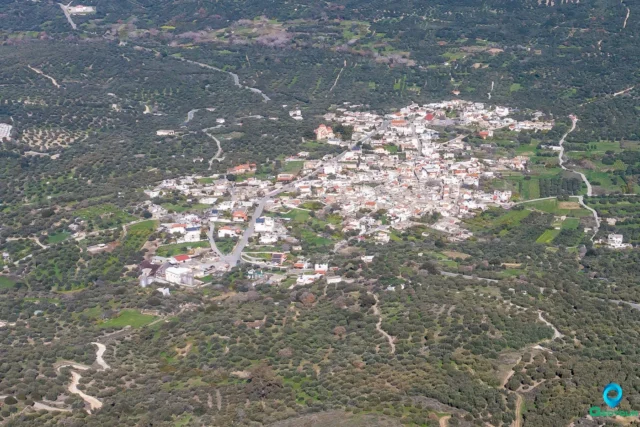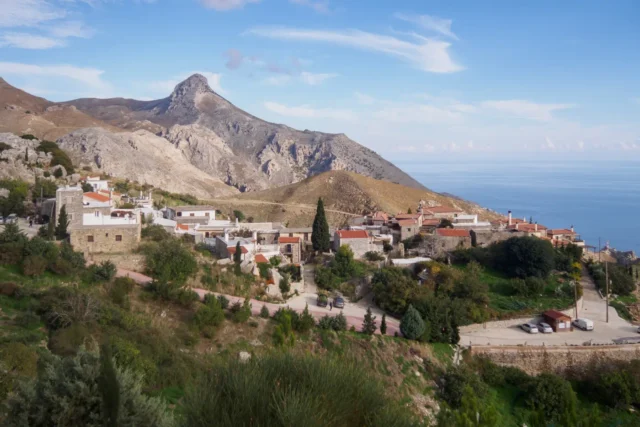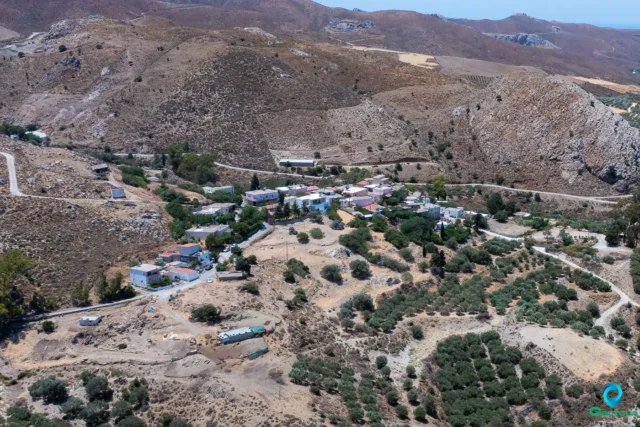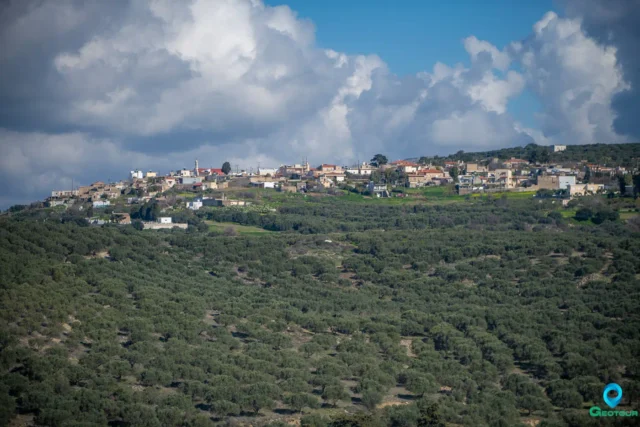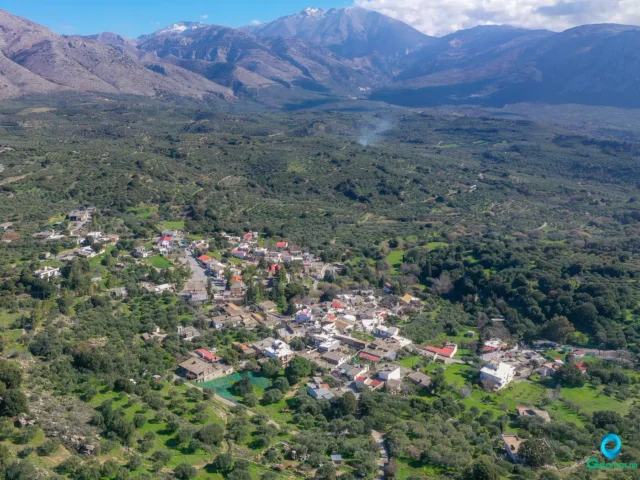829
listings found
Categories
Active filters:
Panagia, Minoa – Pediada
Panagia, a village in the Municipality of Minoa Pediada, Heraklion, Crete, is located 36 km southeast of Heraklion city at an altitude of 360 meters. The village has a rich history dating back to the Venetian period in the 13th century, with evidence of a Venetian castle and the Byzantine Monastery of Panagia Psomopoula. The village is mentioned in various historical records from 1577 onwards, including Venetian and Turkish censuses. Today, Panagia is an active village with a primarily agricultural economy focused on olive oil production. The village also features several landmarks, including the Church of the Dormition of the Theotokos, the Church of Agios Dimitrios, the Church of Agios Konstantinos, a Venetian fountain, the Church of Agia Triada, and a traditional olive mill.
Paranymfoi, Archanes – Asterousia
Paranymfoi is a small, picturesque village nestled in the Asterousia Mountains of Crete, with a history stretching back to the 13th century. The village is mentioned in Venetian records and Ottoman censuses, bearing testament to its long history. The rugged terrain has contributed to a strong sense of community and self-reliance among its inhabitants, who have traditionally been involved in agriculture and animal husbandry.
Paranymfoi's strategic location made it an important stopover for travelers and traders in the past. Today, it continues to attract visitors with its stunning panoramic views, which include the Libyan Sea. The village also serves as a starting point for exploring the Asterousia Mountains, offering a unique blend of natural beauty and historical significance.
A small folklore museum, established by the local cultural association, showcases the traditional way of life in the region. The museum houses a collection of old objects used in weaving, storage, agricultural work, and various household items. The church of Agios Pavlos, with its remnants of frescoes, stands as a reminder of the village's rich past. Paranymfoi's enduring presence and unique character make it a hidden gem in the tapestry of Cretan history.
Azokeramos, Siteia
Azokeramos, a small village in eastern Lasithi, Crete, is located on the northern slopes of Mount Traostalos. Recognized as a settlement in 1925, it's part of the Sitia municipality. The village features traditional stone architecture and several churches, including the Byzantine Agios Ioannis. The surrounding area includes a fertile valley with olive trees and the rugged terrain of Mt. Traostalos, offering panoramic views. Azokeramos, with a historically declining population, maintains its rural Cretan character and agricultural traditions.
Chamaitoulo, Siteia
Chamaitoulo, a small, mountainous village in the Lasithi region of Crete, sits at 590 meters altitude near Ziros. Its few residents primarily raise livestock. The village contains the Agios Georgios church with a wood-carved iconostasis and an ancient water fountain. Neolithic settlement ruins lie 2 kilometers away. The population has dwindled over the years, from 22 in 1650 to just a handful today. It is 7 kilometers from Ziros and 34 kilometers from Sitia.
Loukia, Gortyna
Loukia, located in the Asterousia Mountains of Crete, is a village with a rich history dating back to at least 1368. Records indicate its existence under both Venetian and Ottoman rule. The village, situated 67 kilometers south of Heraklion, has a population of 155. Loukia features traditional architecture, some of which is in disrepair. Despite its small size, the village maintains a primary school, churches, and a cultural association dedicated to preserving its heritage.
Kapetaniana, Gortyna
Kapetaniana is a settlement located in the Heraklion regional unit on the island of Crete, Greece. It belongs to the Municipality of Gortyna
Fournofarango, Gortyna
Fournofarango is a settlement located in the Heraklion regional unit on the island of Crete, Greece. It belongs to the Municipality of Gortyna
Temenia, Kandanos – Selino
Temenia is a settlement located in the Chania regional unit on the island of Crete, Greece. It belongs to the Municipality of Kandanos - Selino
Koumasa, Gortyna
Koumasa, a Cretan village with a long history, is located in the Gortyna municipality on the foothills of the Asterousia Mountains. It is known for its archaeological sites, including tombs and settlements from various Minoan periods.
The village's history dates back to at least 1368 during the Venetian period. The name "Koumasa" likely comes from the word "koumos," meaning a temporary shelter for animals.
A research program led by Professor Diamantis Panagiotopoulos is currently excavating and studying the settlement and necropolis. Discoveries include a Pre-palatial and Old Palace period necropolis, a New Palace period settlement, and an Early Minoan underground burial deposit.
With 69 inhabitants, Koumasa maintains a tranquil atmosphere. The village continues its agricultural traditions, while the archaeological research attracts visitors.
Elos, Kissamos
Elos is a settlement located in the Chania regional unit on the island of Crete, Greece. It belongs to the Municipality of Kissamos
Nteres, Platanias
Nteres is a settlement located in the Chania regional unit on the island of Crete, Greece. It belongs to the Municipality of Platanias
Nea Roumata, Platanias
Nea Roumata is a settlement located in the Chania regional unit on the island of Crete, Greece. It belongs to the Municipality of Platanias
Geraki, Minoa – Pediada
Geraki, or Gerakion, is a village in the Municipality of Minoa Pediada, Heraklion, Crete. It sits on the western slopes of Mount Sarakeno in the Dikti mountain range. The name Geraki is thought to originate from the first settler, Gerakis, documented in the Ducal Archives of Chandax in 1394. The village's economy is based on agriculture, including olive oil, raisins, grapes, and cereals, along with livestock. Notable landmarks include the Church of the Synaxis of the Archangels Michael and Gabriel, known for its frescoes, and the Geraki Gorge, a site of natural beauty with a history connected to the 1867 revolution. The neighboring village of Armacha belongs to the same Community. Geraki has appeared in censuses since 1583 and has a fluctuating population, currently around 254. It remains an active village with a primary school and a cultural association.
Kassanoi, Minoa – Pediada
Kassanoi is a settlement located in the Heraklion regional unit on the island of Crete, Greece. It belongs to the Municipality of Minoa - Pediada
Koxari, Chersonissos
Koxari is a village in the municipality of Hersonissos, in the regional unit of Heraklion, Crete, Greece. It is part of the municipal unit of Gouves. The village is situated […]
Afrati, Viannos
Afrati is a traditional village in Viannos, Crete, situated 45 km southeast of Heraklion at an altitude of 480 meters. The village features traditional architecture, and residents are primarily involved in olive and grape cultivation. The origin of the village's name is uncertain, with possible links to the Greek word for "foam," the ancient city of Arcadia, or the Latin word for "monk."
The area around Afrati has been inhabited since ancient times. The nearby hill of Prophitis Ilias was home to the ancient city of Arcadia, which minted its own coins and later became a bishop's seat. Archaeological excavations have revealed ancient houses, a necropolis, and a 7th-century BC oinochoe (wine jug). Afrati first appears in historical records in the 1881 Turkish census as "Frati." The village features the Church of the Transfiguration of the Savior and offers access to the ruins of Arcadia.
Roussochoria, Minoa – Pediada
Roussochoria is a settlement located in the Heraklion regional unit on the island of Crete, Greece. It belongs to the Municipality of Minoa - Pediada
Nipiditos, Minoa – Pediada
Nipiditos is a settlement located in the Heraklion regional unit on the island of Crete, Greece. It belongs to the Municipality of Minoa - Pediada
Lefkochori, Minoa – Pediada
Lefkochori, formerly Voutoufou, is a semi-mountainous village in the Heraklion Regional Unit on the island of Crete, Greece. The name "Lefkochori" translates to "white village," adopted in 1955 due to the abundance of poplar trees. Byzantinologist Periandros Epitropakis suggests the older name "Voutoufou" is Frankish for "peak of fire," indicating the village may have been used as a beacon. Historical churches include the Church of Agios Georgios and Agios Ioannis, the Church of Panagia, and the Church of the Metamorphosis of the Savior with 13th-century Byzantine frescoes. The area has interesting toponyms like Sarakina, Belvedere, and Foresi.
Rodovani, Kandanos – Selino
Rodovani is a settlement located in the Chania regional unit on the island of Crete, Greece. It belongs to the Municipality of Kandanos - Selino









